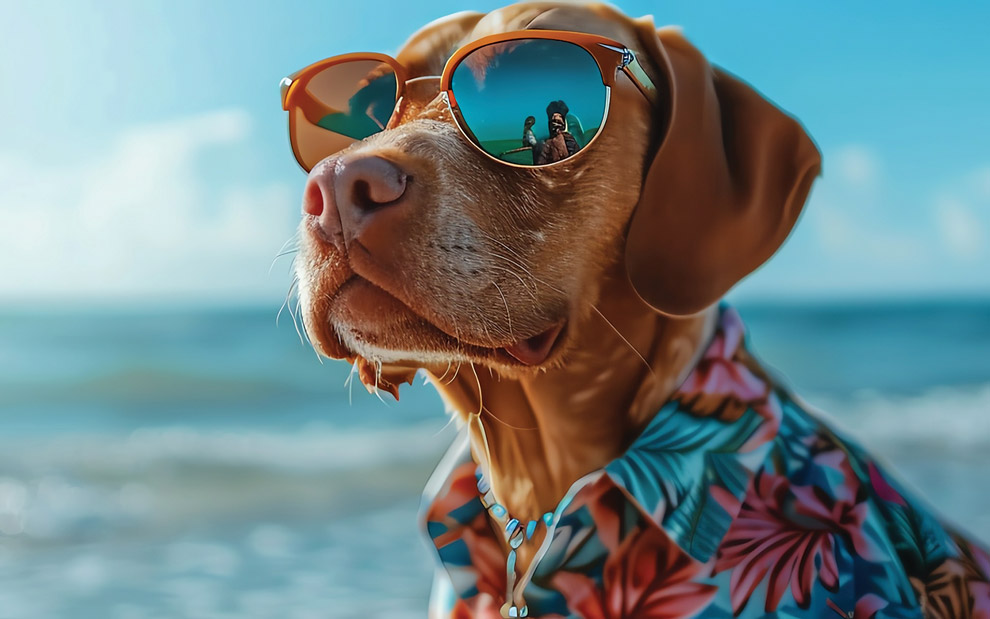One of the best things about living in our area is the ability to take a day trip to the beach. Another great thing is that dogs are allowed in Virginia Beach all year round, even though hours and some areas are restricted from Memorial Day through Labor Day.
Dogs love the beach! There is something about the wide-open spaces and the splashing waves that gets those tails wagging. Of course, we want them to have a good time, but we need to be aware of some potential dangers that the beach and sand can introduce. As conscientious dog parents, we are all aware of safety measures and the dangers of heat for our dogs, so let’s talk about some of the lesser-known dangers your dog may face during a day at the beach.
- Sandburs/Spurs
Anyone who has walked barefoot at the beach has surely encountered bur-grasses. Some people call them sandburs or sandspurs. They are little seeds with tiny spikes and can be very painful if stepped on. Imagine all the little crevices in our dog’s feet and how those burs can push their way up between the pads. Not only is that painful, but if not removed, the plant material can cause infection and lameness.
If you walk your dog on the beach, it would be helpful to carry tweezers so that you can quickly remove any spurs that have attached to your pup. If your dog begins limping, check for sandburs between their pads. When you leave the beach, examine your dog carefully, paying close attention to feet, armpits, tail, around their faces, and in their ears. Sandspurs are nasty little buggers and they latch on to anything and everything. - Sago Palms
These sun-loving plants are not technically palms, but they look like them and make for beautiful landscaping at the beach. Unfortunately, these common plants are poisonous for dogs, cats, horses, and people to ingest. The ASPCA states that ingesting sago palms causes vomiting, gastrointestinal bleeding, jaundice, increased thirst, hemorrhagic gastroenteritis (sudden vomiting and bloody diarrhea), bruising, coagulopathy (preventing the blood from clotting), liver damage, liver failure, and death. Keep your dog away from sago palms. - Saltwater Poisoning
The first time you take your dog to the beach, they have to taste the water, right? And that usually puts an end to it when they realize that it’s not the same stuff that’s in their water bowl. However, a dog can unintentionally ingest a lot of salt water by fetching, swimming, and playing in the ocean. While ingesting a very small amount of salt water may only present mild intestinal issues, too much salt water can cause poisoning and can be fatal.Salt draws the water from your dog’s blood and into their intestines. At the least, it will cause mild dehydration. At the most it will cause diarrhea, vomiting, and severe dehydration. When too much salt is consumed, the body’s cells will release their own water to try to counteract. This will throw everything out of balance, causing seizures, loss of brain cells, and kidney damage. According to the American Kennel Club, dogs with toxic levels of sodium in their systems have a mortality rate higher than 50 percent, regardless of treatment. - Seagrass Wrack
Have you seen seagrass on the beach? I know – it’s ugly, it stinks, and it’s a nuisance, but it is a vital part of the marine ecosystem and benefits our atmosphere in ways too numerous to list. Regardless, it’s not pleasant to look at or walk through.
The problem for dogs is what could be in the seagrass wrack, the collective term for different kinds of seaweed and other material that washes onto the beach. As it comes ashore, it brings with it not only seagrasses, but remains of dead sea animals, trash (like rotten food), fish hooks, needles, broken glass, shells, dead jellyfish (they can still sting after they’re dead!), crabbing gear, crustaceans, netting, mammal carcasses, and all kinds of nasty stuff that your dog should not get into. The longer sea grass sits on the beach, the nastier it becomes, as bacteria, fungi, and other microbes are hard at work breaking it down. It’s just gross!
Norfolk Wildlife Trust advises beach goers to keep pets under close supervision while walking on the beach. They warn that dogs should not eat anything washed up on the shore, as some dead animals can be toxic. - Sand Impaction
Crazy, but true, some dogs eat sand. As a dog lover, you are probably aware that some dogs will eat anything – cell phones, rocks, shoes – so why not sand? Sometimes it is just an accident. When a dog’s fetch toys and balls are covered with sand at the beach, or they lick their fur after being covered with sand, or they dig in the sand and it gets in their mouths as they pant, sand can be unintentionally consumed. If you visit a sandy area with your dog, it is possible that they can end up with sand in their belly for any number of reasons.
If a dog swallows a lot of sand, it can cause a blockage in the intestine. It is called sand impaction. It is rare – thank goodness! – but serious, and requires an urgent visit to the veterinarian emergency clinic. Vomiting, abdominal pain, restlessness or lethargy, and dehydration are signs that your dog may have accumulated too much sand. Unchecked, it can be fatal. Prognosis is promising if treatment is carried out promptly.
When we are at the beach, we need to monitor our dogs closely and prevent them from eating things they shouldn’t eat, drinking things they shouldn’t drink, and making sure they don’t get into something that could potentially cause them to be sick or even die. An emergency veterinarian visit can ruin an otherwise beautiful vacation or day trip at the beach!





